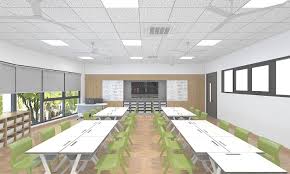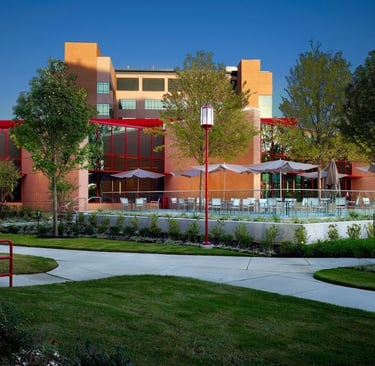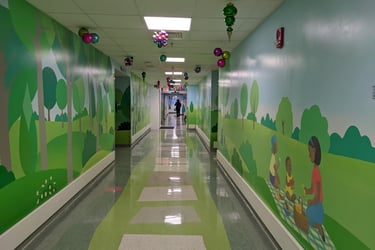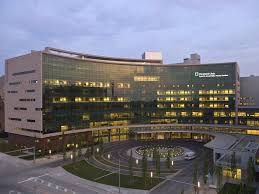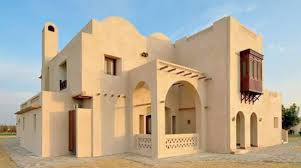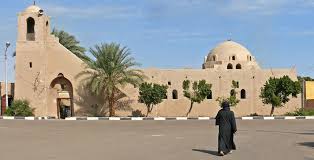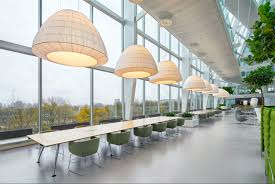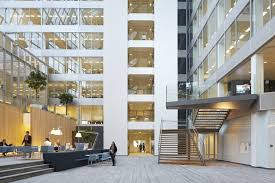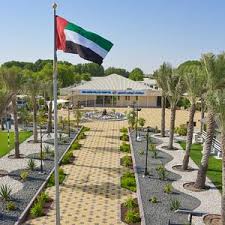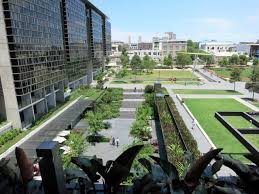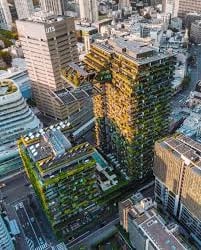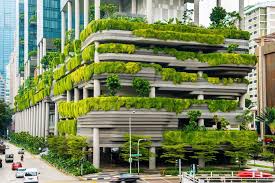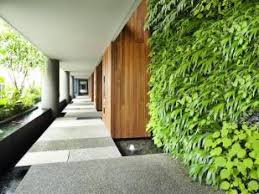
Does Architectural Design Affect the Quality of Life???
Highlighting the close relationship between architectural design and quality of life and how each element in design affects our mental and physical health, our productivity and even our social relationships and how we can benefit from this effect to create healthier and happier environments
Construct vision team
11/29/202418 min read
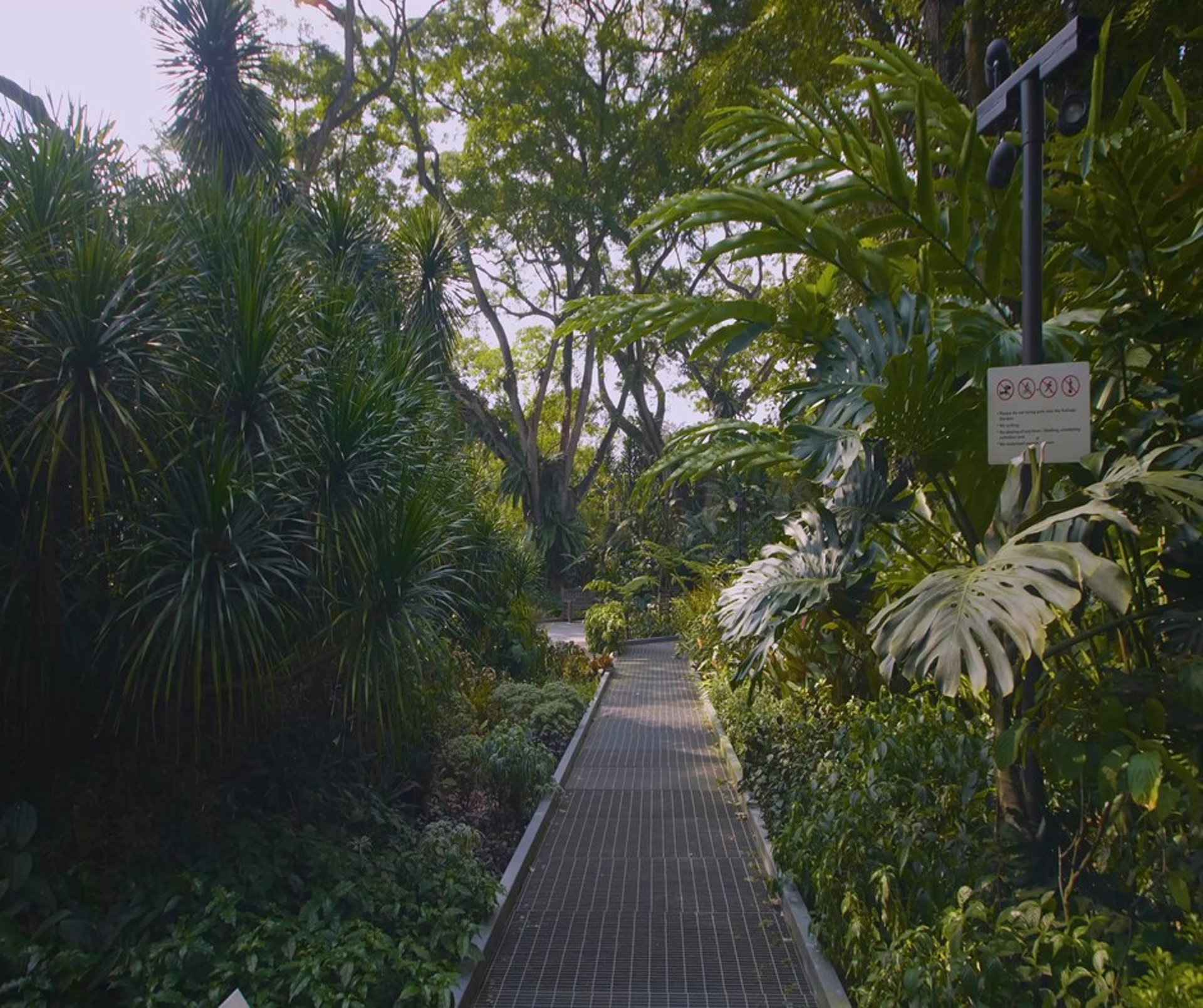
Introduction:
Have you ever felt relaxed and comfortable in certain places, while feeling anxious and tense in others without understanding why?
Have you ever wondered how your designs, whether it's a house or a city plan, can impact individuals' psychological state or daily productivity?
How can architectural design transform daily life into a more positive and inspiring experience?
The environment around us, whether it's our home, office, or the city we live in, plays a significant role in determining the quality of our lives. Architectural design is not just about building walls and roofs; it's an art that creates spaces that reflect our identity and meet our needs. In this article, we will explore the close relationship between architectural design and the quality of life, and how each element of design affects our psychological and physical health, productivity, and even our social relationships. We will also discuss how we can utilize this impact to create healthier and happier environments.
The Impact of Architectural Design on Different Aspects of Quality of Life
First: Psychological and Physical Health
Colors: Colors have a powerful impact on our psychology. Warm colors like red and orange increase energy and activity, while cool colors like blue and green induce calmness and relaxation.
Light colors can improve the perception of people in small and narrow spaces, giving a sense of spaciousness. Conversely, in wide and spacious areas, dark colors provide a better sense of space. The field of colors is vast, with numerous studies and statistics exploring the reflection of each color on the psychological state and the improvement of the perception of spaces and heights. Colors also convey important psychological messages to space users, such as alerting, awakening memories, or creating a sense of danger.
Open Spaces: The feeling of spaciousness and good ventilation in open spaces reduces stress and anxiety, promoting a sense of comfort and happiness. Studies have shown that patients in hospitals with large windows and green spaces recover faster and suffer less from depression.
Natural Lighting: Improves mood as natural light regulates the body's biological clock. Adequate sunlight exposure helps produce vitamin D, which is essential for bone health and disease prevention. Studies have shown that individuals working in offices with sufficient natural lighting experience fewer sleep problems and get adequate rest.
Good Ventilation: Clean air improves lung function and reduces the risk of respiratory diseases. It also increases concentration and alertness, enhancing cognitive performance.
Second: Productivity and Focus
Intelligent Interior Design: Logical and clear arrangement of spaces and furniture reduces distraction and increases efficiency. Similarly, ergonomic office furniture helps maintain proper body posture and reduces fatigue. Studies have shown that employees working in well-designed offices are 20% more productive and less prone to stress.
Space Allocation: Allocating different spaces for different activities (work, relaxation, meetings) increases efficiency and reduces distraction.
Storage: Providing adequate storage spaces helps organize work and easily locate items. Often, this aspect is not given enough attention, resulting in storage spaces that are insufficient for the architectural functions designed, causing chaos and randomness in space usage.
Isolated Spaces in the Workplace: Enhance focus and productivity, especially for tasks requiring deep thinking and creativity. They also provide a quieter and more private environment, which may improve job satisfaction. Open offices encourage collaboration and communication among employees and may be suitable for tasks requiring teamwork and collaborative problem-solving. However, they can lead to increased distraction and reduced focus, especially for individuals who need a quiet environment to work.
Some studies indicate that employees working in isolated spaces are 15% to 20% more productive than their colleagues working in open offices. These studies also suggest that employees working in isolated spaces are more satisfied with their jobs and less prone to stress. In contrast, employees working in open offices are more likely to catch the flu and colds due to increased exposure to sick individuals. Additionally, open offices encourage informal communication and hinder effective and deep communication. Therefore, office design should align with the company's culture and goals. Sometimes, a combination of open offices and isolated spaces can be implemented to meet the needs of different employees, as there is no one-size-fits-all solution.
Third: Social Environment and Relationships:
Architectural design that encourages social interaction (shared spaces):
Architectural design plays a significant role in promoting social interaction by creating spaces that invite gathering and communication, while reducing isolation and individualism. Shared spaces within homes, public places, or residential units enhance relationships between individuals and create a friendly and comfortable environment. Architects' efforts in devising solutions to create these spaces and guide their collective use effectively strengthen the idea of joint activity for the family or residents of a single building. Examples include:
Open Spaces: Open spaces in homes (such as a living room connected to the kitchen) facilitate family interaction while engaging in different activities.
Functional Gathering Places: Designing comfortable seating areas around a fireplace or in a quiet corner encourages family gatherings or friends' meetings. Alternatively, the goal may be to gather employees of a single institution during the break in one place and direct them to engage in beneficial shared group activities, thereby improving relationships and directing them towards general benefit and effective cooperation.
Public Spaces in Residential Buildings: Shared gardens, gyms, or meeting rooms in residential complexes encourage the building of new relationships between neighbors.
Furniture Designed for Interaction: Such as large dining tables or sofas designed to encourage sitting in a circle.
Such ideas promote a sense of belonging and social bonds, reducing social isolation, especially in large cities. Additionally, the concept of an inclusive environment is very important, enabling all individuals, regardless of their age group or physical abilities, including those with special needs, to freely and easily practice their activities with justice.
Fourth: Sound Insulation Reduces Stress and Improves Relationships Within the Home:
Excessive noise within the home can cause stress between family members and hinder concentration, which may negatively impact relationships. When good architectural design takes effective sound insulation into account, it provides a quiet and comfortable environment. This can be achieved through:
Building Material Selection: Using sound-insulating walls, double-glazed windows, and thick carpets or rugs reduces noise transmission.
Wise Space Division: Allocating quiet spaces such as bedrooms or study rooms away from noise sources (such as the kitchen, living room, or children's playroom), with dividing walls of thicknesses and materials that reduce sound transmission to bedrooms.
Soundproof Doors and Windows: Solid doors and high-quality windows help reduce external sounds.
Sound-Absorbing Ceilings: Using sound-absorbing ceiling panels prevents sound propagation between floors. When using suspended ceilings, this provides a separating void between floors, resulting in sound insulation between floors. Such solutions are necessary, especially in cases where different functions are present between floors or different social situations, such as an apartment with children below an apartment inhabited by elderly people who need quiet and rest. In such cases, floor insulation is an acceptable and suitable solution.
Providing a quiet environment reduces the psychological stress resulting from noise and helps individuals sleep better, which positively reflects on their mood. It also improves family relationships by reducing noise, thereby limiting conflicts that may arise due to continuous annoyance. It provides separate spaces for each activity in the family, ensuring a healthy balance between interaction and independence.
Combining the encouragement of social interaction and respect for sound privacy in architectural design creates a balanced environment that improves the quality of life. Paying attention to these details yields very good results regarding psychological comfort and effective communication.
Fifth: Sustainability and Environmental Comfort:
Green Architecture and Reducing Resource Consumption:
Green or sustainable architecture is an approach to designing and constructing buildings aimed at reducing negative environmental impact and reducing the consumption of natural resources. It involves using environmentally friendly building materials and avoiding harmful materials to health and the environment.
Buildings are designed to reduce energy consumption through insulation, using double-glazed windows, and implementing energy-efficient heating and cooling systems. Renewable energy sources such as solar and wind power are relied upon to generate electricity and provide hot water. Rainwater collection systems and greywater recycling systems are also implemented to reduce the consumption of freshwater.
Buildings are designed to suit the local climate, providing natural ventilation and natural lighting. Many architectural techniques and ideas are used in this field, such as green roofs that insulate the building, reduce surface runoff, and improve air quality. Walls are thermally and acoustically insulated with environmentally friendly materials, and smart lighting systems such as sensors are used to adjust lighting automatically as needed, reducing energy consumption.
Smart Homes and Improving Comfort and Time Savings:
Smart homes are equipped with advanced technological systems that allow remote control of various devices and systems within the home, providing comfort and helping save time and effort. Smart home features include:
• Remote Control: Lighting, temperature, household appliances, and security systems can be controlled through a smartphone app or tablet.
• Automation: Devices can be programmed to work automatically, such as turning on lights at dusk or adjusting the temperature before arriving home.
• Efficiency: Smart systems help rationalize energy and water consumption, reducing the economic pressure resulting from high consumption.
• Security: Smart security systems provide greater protection for homes through cameras and sensors.
Sixth: The Concept of Therapeutic Environment and Emotional Design:
Therapeutic Environment:
Includes the physical and psychological space in which healthcare and psychological treatment are provided, and all elements surrounding patients, such as architectural design, décor, lighting, colors, and furniture.
The therapeutic environment affects the psychological state, creating an atmosphere of calm and relaxation, or vice versa, increasing tension and anxiety. A positive therapeutic environment helps enhance the healing process by creating a sense of safety and comfort and reducing feelings of loneliness and isolation. An open and friendly therapeutic environment may facilitate communication between the patient and the therapist, thereby improving treatment outcomes.
Therefore, architectural design should be comfortable and calm, using natural materials and soft colors. Décor can be used to add a positive touch to the therapeutic environment, making it a comfortable and motivating place. Lighting should be suitable for the type of treatment provided, where dim lighting can create a relaxing atmosphere, and bright lighting can increase alertness and focus. Colors have a significant impact on the psychological state, so they should be chosen carefully to suit the type of treatment provided. Furniture should be comfortable and practical and suit the size and use of the room.
For example: Medical spaces such as waiting rooms can be designed with soft colors and dim lighting, with the presence of natural plants and comfortable artwork to reduce stress and anxiety among patients and visitors. Rehabilitation centers can be designed with warm colors and natural lighting, with open spaces and areas for activities, encouraging movement and social interaction. Hospital patient rooms can be designed with soft colors and adjustable lighting, with large windows allowing natural light to enter and providing views of nature.
Emotional Design:
Focuses on creating positive emotional experiences for users. This is achieved by designing products, services, and environments in a way that evokes certain emotions in users, such as happiness, satisfaction, and comfort.
Emotional design can significantly improve users' experience of spaces by creating a comfortable or motivating environment. It can help increase commitment, such as an employee's commitment to their work or a patient's commitment to their treatment, by making them feel part of the place's activities and a key factor in its success.
Emotional design includes the aesthetics of the environment using attractive colors, shapes, and fabrics, as well as the interaction that the space allows users to engage in different activities. It also includes the ability of this environment to be customized, allowing users to adapt it to their needs and preferences.
Using natural elements such as plants adds a touch of life to the space and provides suitable places for relaxation and meditation.
For example: In public places such as libraries, exhibitions, and different activity venues, art can be used as a tool for self-expression and communication with others. In these cases, it is also beneficial to use flexible spaces that can adapt to the different needs of users, including those with special needs, while providing a high degree of safety and protection from hazards.
Here, the importance of continuous evaluation and the architect's awareness of studies, surveys, and statistics that are constantly evolving with every local or global experience emerges as a key factor in development and continuous improvement based on user feedback and observations.
It is also necessary to mention the concept of Sensory Design:
It is an approach that takes into account not only visual and architectural aspects but also how people interact with the architectural space through their different senses. The impact of architectural design on the five senses of individuals leaves a deep psychological reflection.
Using materials that provide a natural texture (such as wood or stone) to stimulate touch, and designs that spread a natural scent such as indoor gardens or plants improve mood.
Suitable lighting creates a comfortable and stimulating environment or creates anxiety, depending on the activities within each space.
Smart technology in design, such as adjustable lighting or automatic temperature control, and ventilation sensors, enhance the feeling of well-being.
Promoting mental health by creating spaces that encourage meditation, such as corners equipped with comfortable seats and natural visual views, reduce anxiety and depression. Design therapy has become a recognized approach to improving mental health and is particularly applied in hospitals and treatment centers, as mentioned earlier.
Even small details, such as choosing door handles or floor colors, play a role in promoting comfort or tension.
Focusing on the psychological messages conveyed by the work environment through its interior and exterior design has a direct impact on productivity and creativity. Companies that pay attention to these details in a scientific and well-thought-out manner witness an increase in employee satisfaction and efficiency.
Community-Oriented Design that suits the users of spaces, their needs, and activities so that these spaces become an attractive environment for these people and a strong incentive for more positive behaviors, enhancing their sense of belonging and interaction with their social environment.
Examples of Healthy and Educational Buildings Applying These Two Principles - Therapeutic Environment and Emotional Design:
1. St. Jude Children's Hospital in Memphis, Tennessee:
The hospital is distinguished by its innovative design resembling an amusement park, with colorful corridors, attractive artwork, and large play areas. The main goal was to alleviate stress and anxiety among sick children and their families and make the treatment experience as enjoyable as possible. Bright colors, cheerful lighting, interactive artwork, open spaces, and nature were used in both indoor and outdoor spaces.
2. Cleveland Clinic Hospital in Ohio:
The design focuses on using natural materials such as wood and stone and introducing natural light into as many spaces as possible. The design aimed to create a quiet and comfortable environment for patients and enhance the healing process. It used indoor gardens, large windows, natural lighting, and soft colors.
3. Sandwell Children's Center in Boston:
The center is based on the concept of the "health village," where a variety of services are provided in one place, including healthcare, education, and recreational activities. The goal was to provide a supportive environment for children and their families and facilitate the treatment process. The designer used open spaces, bright colors, interactive artwork, and natural spaces.
In general, what distinguishes such experiences is the focus on the user experience, as these buildings are designed with the users' needs in mind, whether they are patients or visitors.
In the Arab world, there are many promising experiences in health buildings, such as:
• Environmentally designed hospitals: There are many hospitals in the Arab Gulf countries that have been designed to be environmentally friendly and provide a comfortable therapeutic environment for patients. These hospitals use natural materials and provide natural lighting and ventilation.
• Community Health Centers: Many community health centers are emerging in Arab countries that focus on providing comprehensive health services in a comfortable and supportive environment.
• Health Hotels: There are hotels in some Arab countries that offer health programs and use interior and exterior designs that promote relaxation and psychological support.
• Mosques: Mosques in the Arab world and places of worship in general can be considered examples of buildings that apply the concept of a therapeutic environment, as they provide an atmosphere of calm and tranquility and encourage meditation and reflection.
There are many experiences in educational buildings that are worth contemplating and have succeeded in many aspects, such as the Future Schools in the Gulf countries that rely on the latest technologies and innovative designs to create a stimulating educational environment. These schools often use natural elements, provide open spaces, and use natural lighting and ventilation techniques. Sustainable educational projects in the Arab world focus on environmental sustainability and use environmentally friendly building materials and renewable energy technologies. These projects often provide a healthy and comfortable educational environment for students.
In general, using suitable colors and lighting and using natural materials in decor, introducing plants and natural light into classrooms, providing shared spaces for students to interact and collaborate, such as school libraries and cafeterias, and using technology creatively to enhance the learning experience, as well as allocating private spaces for students to study and rest, all make the educational experience an exciting and enjoyable one and improve the role of educational buildings in developing students' personalities and motivating them significantly, especially since they spend long hours in their schools. This shows the great role of educational buildings in improving the quality of life.
We also mention educational buildings inspired by architectural heritage with a modern touch. These buildings often use traditional building materials and provide a sense of cultural identity.
The Arab world possesses a rich architectural heritage that combines natural elements and traditional designs that can be a source of inspiration for contemporary healthy designs, especially since the Arab region faces multiple health challenges, such as the spread of chronic diseases and high rates of stress and fatigue. Therefore, health buildings can contribute to improving public health and improving the quality of life. The rapid urban growth witnessed in the Arab world also makes it necessary to design buildings in a sustainable and healthy manner.
However, there are undoubtedly obstacles that play a significant role in limiting such experiences, such as cost, lack of expertise and skills needed to implement these projects, and the most important factor is the will and need to modify regulations and laws to facilitate the application of these concepts.
What is most important to provide in schools:
Focusing on health and psychological state by providing a healthy and safe environment for students, and the design must be flexible, allowing the innovative designs of these schools to modify classrooms to suit different educational activities, encouraging active and interactive learning.
Environmental sustainability: The designer must pay attention to using these schools with environmentally friendly building materials and renewable energy technologies, reducing their negative environmental impact. These schools must also be concerned with social and economic sustainability.
Investment in research and development to develop solutions and benefit from real-life experiences, adapting them to local conditions, and involving the local community in the design and construction process of schools to ensure that their needs and aspirations are met.
Here, we must mention three outstanding examples of sustainable buildings and the reflection of the concept of green architecture and sustainability on the quality of life in the architectural and urban environment:
1. The "Qurna Village" Project by the Pioneer of Sustainable and Heritage Architecture Hassan Fathy:
An architectural masterpiece inspired by heritage, "Qurna Village," designed by the renowned Egyptian architect Hassan Fathy, combines authentic Egyptian heritage with innovative design to provide a sustainable and comfortable living environment.
Fathy drew inspiration from traditional Nubian architecture, using mud bricks as the primary building material. Any architect is aware of the advantages of this type of brick in terms of being an environmental and locally available material, as well as its ability to insulate heat and cold and its ease of manufacture.
Natural Ventilation: Fathy designed the houses to be naturally ventilated, utilizing traditional architectural techniques used in the past. This was achieved through upper and lower openings that allow fresh air to enter and hot air to exit. Additionally, the houses were designed to make the most of natural sunlight, reducing the need for artificial lighting.
Fathy allocated spacious shared spaces between the houses, such as courtyards and passages, to encourage social interaction among the residents.
The living environment in Qurna is a healthy one, as the houses made from mud bricks are healthier compared to those made from industrial materials. Mud brick houses allow the walls to breathe and prevent moisture buildup. The natural and peaceful environment of Qurna, combined with the beautiful architectural design, contributes to creating a sense of psychological comfort and tranquility for the residents.
Qurna is considered a model of a sustainable village, reflecting the Egyptian cultural identity and contributing to preserving authentic Egyptian architectural heritage. Despite the challenges faced by Qurna, such as climate changes (like rising temperatures and drought) and population growth, which led to increased pressure on natural resources and infrastructure, as well as the difficulty of obtaining the necessary funding for its maintenance and development, Qurna remains a role model in the field of sustainable and heritage architecture. It serves as evidence that it is possible to build comfortable and beautiful homes while preserving the environment and our cultural heritage.
2. The Edge Project in Amsterdam:
The Edge building in Amsterdam is the most sustainable office building in the world and has received a BREEAM-NL rating of 98.36%. It is a net-zero energy building, producing 102% of its energy.
The Edge building in Amsterdam is one of the most prominent examples of smart and sustainable buildings in the world. The building was designed to be environmentally friendly and energy-efficient, featuring many smart features such as:
• Smart Lighting: Lighting adjusts automatically according to the time of day, movement of people, and weather conditions.
• Smart Ventilation System: Ensures continuous circulation of fresh air and improves indoor air quality, providing clean and comfortable air.
• Smart Sensors: Monitor air quality, humidity, and temperature, automatically adjusting the systems.
• Smart Communication: Employees can book meeting rooms and organize meetings through a smartphone app, allowing employees to control the work environment through their smartphones.
The building achieved significant energy savings compared to regular buildings, and employees showed increased productivity and job satisfaction. The building also contributed to a significant reduction in carbon emissions.
The building's unique design combines elegance and functionality, using natural materials such as wood and glass. It relies on smart technologies and utilizes solar energy and rainwater harvesting mechanisms.
The building provides diverse workspaces to meet the needs of different employees, from open spaces for communication to private meeting rooms. The design focuses on employee well-being by providing relaxation and exercise spaces, as well as restaurants and cafes.
Despite the high costs of construction, operation, and maintenance required for such buildings, it is considered a role model in the field of sustainable construction and smart homes. The building has inspired many companies and institutions to adopt sustainable building practices.
3. Masdar City - United Arab Emirates:
Masdar City in Abu Dhabi is one of the most prominent examples of sustainable urban projects in the Arab region. The city was designed to be a model of a sustainable city that relies on renewable energy and smart technologies.
The main features that distinguish Masdar City include:
• Reliance on Solar Energy: Solar energy is the primary energy source in the city, with buildings covered in solar panels to generate electricity.
• Innovative Cooling System: A central cooling system is used to cool the ambient air before it enters the buildings, reducing the need for traditional air conditioning units.
• Sustainable Transportation: The city encourages the use of sustainable transportation methods such as electric bicycles and electric buses.
• Sustainable Construction: Environmentally friendly building materials are used in all buildings, and the buildings are designed to allow natural ventilation and natural lighting.
• Research and Development: The city hosts a research and development center focused on developing new technologies in the field of sustainability.
Masdar City is considered a role model in the Arab region in the field of sustainability and sustainable development. It attracts significant investments from around the world, contributing to the development of the renewable energy sector in the region. The city has also played a role in raising awareness about the importance of sustainability and environmental conservation.
Masdar City highlights the importance of comprehensive planning for sustainable urban projects, taking into account all environmental, economic, and social aspects. Technology played a crucial role in achieving sustainability, helping to improve energy and resource efficiency. The project proved the necessity of close cooperation between the public and private sectors to achieve projects of this size and ambition.
It is worth mentioning that Masdar City is still under development, and there are many other projects being implemented in the region. The project has faced some challenges, such as high costs and climate challenges, but many of these have been overcome through good planning and innovation.
Other buildings in the same context include:
One Central Park, Sydney, Australia:
The building includes a shopping center and two residential towers. It has received many local and international awards in the field of sustainability and energy efficiency savings. This multi-use building is famous for its vertical gardens, blending architecture and greenery to enhance urban life. It features over 250 plant species and uses renewable systems such as water harvesting and solar panels. The design integrates beauty with sustainability, improving air quality and creating a peaceful urban oasis.
PARKROYAL Collection Pickering, Singapore:
This hotel features "sky gardens" throughout its facade, reducing the impact of urban heat islands and enhancing the urban landscape. Rainwater is collected for irrigation, and local plant gardens improve biodiversity while promoting a sense of calm and connection with nature.
Finally:
we can say that architectural design is not just a means to build homes or offices functionally and aesthetically, but it is a key factor that can significantly improve our quality of life on all levels.
Whether you are an architect working on a new design or a non-specialist wanting to improve your current space, remember that small details can make a big difference in the quality of your life.
we conclude with a famous quote from the Sheikh of Architects, Hassan Fathy: "As an engineer, as long as I have the ability and means to make people comfortable, God will never forgive me for intentionally raising the temperature inside a house by 17 degrees Celsius."
Thank you for following along
Construct vision team


